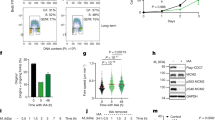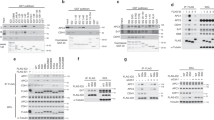Abstract
THE major events of the cell division cycle are triggered by periodic changes in the activity of cyclin-dependent protein kinases (CDKs). In mammals, the members of the CDK family include CDK2 and CDC2, which are thought to be involved in the control of DNA replication and mitosis, respectively1–3. The protein kinase activity of these enzymes is controlled by a complex array of mechanisms4–6. Activation of the CDK catalytic subunit requires association with a positive regulatory subunit (cyclin) and phosphorylation (at Thr 160 in CDK2). This activated complex can be inhibited by additional phosphorylation at Thr 14 and Tyr 15. Here we report the identification of a new mechanism for the regulation of CDK2 activity. We find that CDK2/cyclin complexes in mouse fibroblasts associate tightly with a 20K protein (CAP20). Complexes containing CAP20 were isolated from cell lysates and found to have negligible kinase activity, indicating that CAP20 association in vivo may inhibit CDK2 activity. We purified CAP20 from 3T3 cells and found that low concentrations of the protein completely inhibit the kinase activity of CDK2 in vitro. Thus CAP20 represents a new negative regulatory subunit that inhibits the activity of CDK2/cyclin complexes in mammalian cells.
This is a preview of subscription content, access via your institution
Access options
Subscribe to this journal
Receive 51 print issues and online access
$199.00 per year
only $3.90 per issue
Buy this article
- Purchase on Springer Link
- Instant access to full article PDF
Prices may be subject to local taxes which are calculated during checkout
Similar content being viewed by others
References
Norbury, C. & Nurse, P. A. Rev. Biochem. 61, 441–470 (1992).
Reed, S. I. A. Rev. Cell Biol. 8, 529–561 (1992).
Pines, J. Trends biochem. Sci. 18, 195–197 (1993).
Solomon, M. Curr. Opin. Cell Biol. 5, 180–186 (1993).
De Bondt, H. L. et al. Nature 363, 595–602 (1993).
Draetta, G. Trends Cell Biol. 3, 287–289 (1993).
Gu, Y., Rosenblatt, J. & Morgan, D. O. EMBO J. 11, 3995–4005 (1992).
Xiong, Y., Zhang, H. & Beach, D. Cell 71, 505–514 (1992).
Xiong, Y., Zhang, H. & Beach, D. Genes Dev. 7, 1572–1583 (1993).
Fang, F. & Newport, J. W. Cell 66, 731–742 (1991).
Pagano, M., Pepperkok, R., Verde, F., Ansorge, W. & Draetta, G. EMBO J. 11, 961–971 (1992).
Pagano, M. et al. J. Cell Biol. 121, 101–111 (1993).
Girard, F., Strausfeld, U., Fernandez, A. & Lamb, N. J. C. Cell 67, 1169–1179 (1991).
Ohtsubo, M. & Roberts, J. M. Science 259, 1908–1912 (1993).
Sherr, C. J. Cell 73, 1059–1065 (1993).
Tsai, L.-H., Lees, E., Faha, B., Harlow, E. & Riabowol, K. Oncogene 8, 1593–1602 (1993).
Desai, D., Gu, Y. & Morgan, D. O. Molec. Biol. Cell 3, 571–582 (1992).
Hager, D. A. & Burgess, R. R. Analyt. Biochem. 109, 76–86 (1980).
Koff, A. et al. Science 257, 1689–1694 (1992).
Xiong, Y. et al. Nature 366, 701–704 (1993).
Noda, A., Ning, Y., Venable, S. F., Pereira-Smith, O. M. & Smith, J. R. Expl Cell Res. (in the press).
Harper, J. W., Adami, G. R., Wei, N., Keyomarsi, K. & Elledge, S. J. Cell 75, 805–816 (1993).
Author information
Authors and Affiliations
Rights and permissions
About this article
Cite this article
Gu, Y., Turck, C. & Morgan, D. Inhibition of CDK2 activity in vivo by an associated 20K regulatory subunit. Nature 366, 707–710 (1993). https://doi.org/10.1038/366707a0
Received:
Accepted:
Issue Date:
DOI: https://doi.org/10.1038/366707a0
This article is cited by
-
Therapeutic potential of CDK4/6 inhibitors in renal cell carcinoma
Nature Reviews Urology (2022)
-
Susceptibility of cyclin-dependent kinase inhibitor 1-deficient mice to rheumatoid arthritis arising from interleukin-1β-induced inflammation
Scientific Reports (2021)
-
Identification of candidate genes from androgenic gland in Macrobrachium nipponense regulated by eyestalk ablation
Scientific Reports (2021)
-
Identification of a cellularly active SIRT6 allosteric activator
Nature Chemical Biology (2018)
-
Cell cycle checkpoint in cancer: a therapeutically targetable double-edged sword
Journal of Experimental & Clinical Cancer Research (2016)
Comments
By submitting a comment you agree to abide by our Terms and Community Guidelines. If you find something abusive or that does not comply with our terms or guidelines please flag it as inappropriate.



